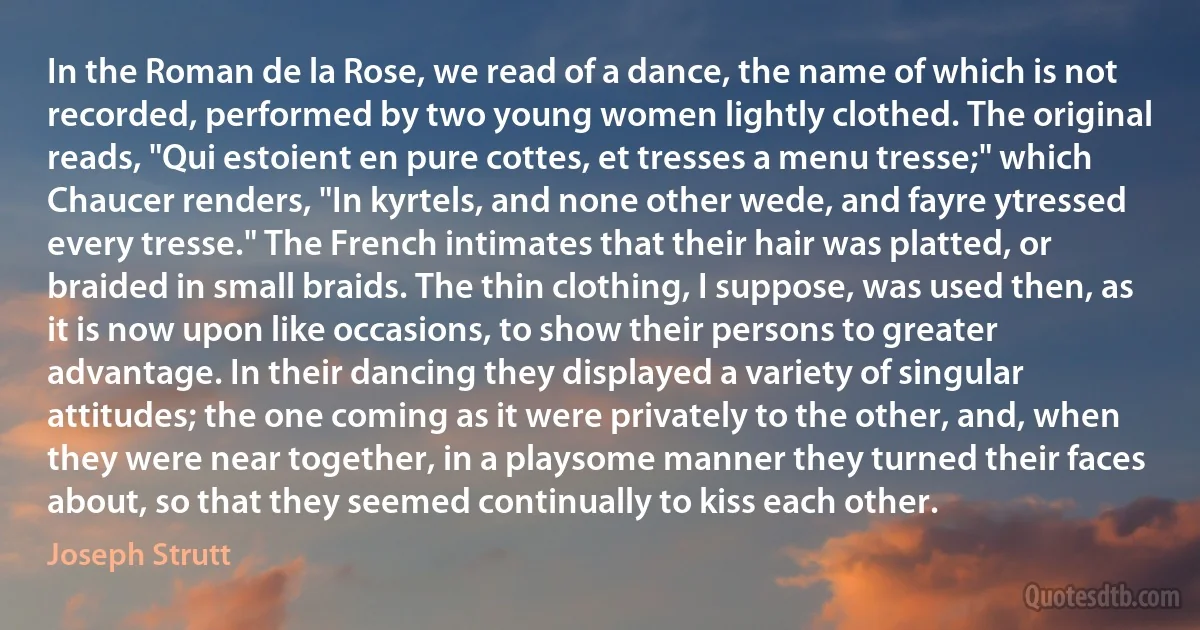
In the Roman de la Rose, we read of a dance, the name of which is not recorded, performed by two young women lightly clothed. The original reads, "Qui estoient en pure cottes, et tresses a menu tresse;" which Chaucer renders, "In kyrtels, and none other wede, and fayre ytressed every tresse." The French intimates that their hair was platted, or braided in small braids. The thin clothing, I suppose, was used then, as it is now upon like occasions, to show their persons to greater advantage. In their dancing they displayed a variety of singular attitudes; the one coming as it were privately to the other, and, when they were near together, in a playsome manner they turned their faces about, so that they seemed continually to kiss each other.
Joseph StruttRelated topics
advantage clothing coming dancing dance french hair women kiss name near none now pure read rose show small suppose thin young ChaucerRelated quotes
Let true Christians then, with becoming earnestness, strive in all things to recommend their profession, and to put to silence the vain scoffs of ignorant objectors. Let them boldly assert the cause of Christ in an age when so many, who bear the name of Christians, are ashamed of Him: and let them consider as devolved on Them the important duty of suspending for a while the fall of their country, and, perhaps, of performing a still more extensive service to society at large; not by busy interference in politics, in which it cannot but be confessed there is much uncertainty; but rather by that sure and radical benefit of restoring the influence of Religion, and of raising the standard of morality.

William Wilberforce
Don't forget that God sees you and watches you when you are in pain; He perceives even the beating of your heart. Consequently, He will not leave you without consolation and His fatherly protection. Naturally, the saints rejoiced in their afflictions; as for us, let us at least manage to accept affliction or pain patiently.
My child, pray within your heart, and the name of Jesus will become for you a comforting balm so that you can bear this trial of yours in a way which benefits you. You will greatly benefit from this trial if you submit yourself to it patiently. So again I say to you, with the almighty armor of prayer continually approach the omnipotent Lord more often, and you will come to know how He wondrously lifts the burden of pain and marvellously gives rest to sufferers.

Ephraim of Arizona
Why should a poet pray thus? poets scorn
The boundaried love of country, being free
Of winds, and alien lands, and distances,
Vagabonds of the compass, wayfarers,
Pilgrims of thought, the tongues of Pentecost
Their privilege, and in the peddler's pack
The curious treasures of their stock-in-trade,
Bossy and singular, the heritage
Of poetry and science, polished bright,
Thin with the rubbing of too many hands;
Myth, glamour, hazard, fables dim as age,
Faith, doubt, perplexity, grief, hope, despair,
Wings, and great waters, and Promethean fire,
Man's hand to clasp, and Helen's mouth to kiss.
Why then in little meadows hedge about
A poet's pasture? shed a poet's cloak
For fustian? cede a birthright, thus to map
So small a corner of so great a world?

Vita Sackville-West
How shall I tell what I saw? The towers are not all broken - here and there one still stands, like a great tree in a forest, and the birds nest high. But the towers themselves look blind, for the gods are gone. I saw a fishhawk, catching fish in the river. I saw a little dance of white butterflies over a great heap of broken stones and columns. I went there and looked about me - there was a carved stone with cut - letters, broken in half. I can read letters but I could not understand these. They said UBTREAS. There was also the shattered image of a man or a god. It had been made of white stone and he wore his hair tied back like a woman's. His name was ASHING, as I read on the cracked half of a stone. I thought it wise to pray to ASHING, though I do not know that god.

Stephen Vincent Benét
As we walked homeward across the fields, the sun dropped and lay like a great golden globe in the low west. While it hung there, the moon rose in the east, as big as a cart-wheel, pale silver and streaked with rose colour, thin as a bubble or a ghost-moon. For five, perhaps ten minutes, the two luminaries confronted each other across the level land, resting on opposite edges of the world.
In that singular light every little tree and shock of wheat, every sunflower stalk and clump of snow-on-the-mountain, drew itself up high and pointed; the very clods and furrows in the fields seemed to stand up sharply. I felt the old pull of the earth, the solemn magic that comes out of those fields at nightfall. I wished I could be a little boy again, and that my way could end there.

Willa Cather
